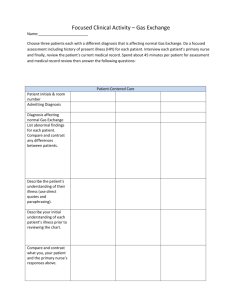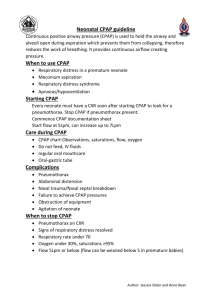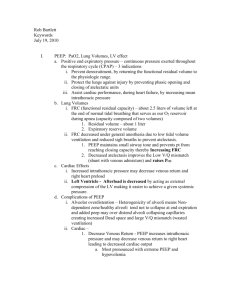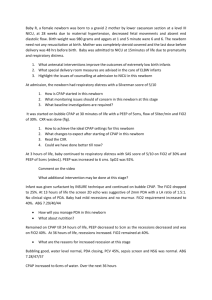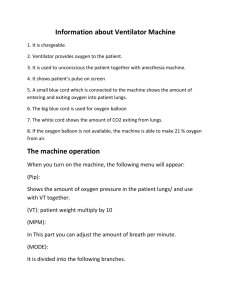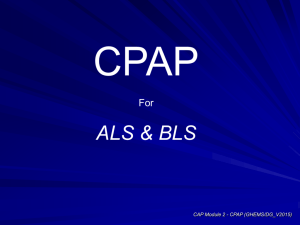CPAP Respiratory Therapy CPAP Overview Applies continuous
advertisement
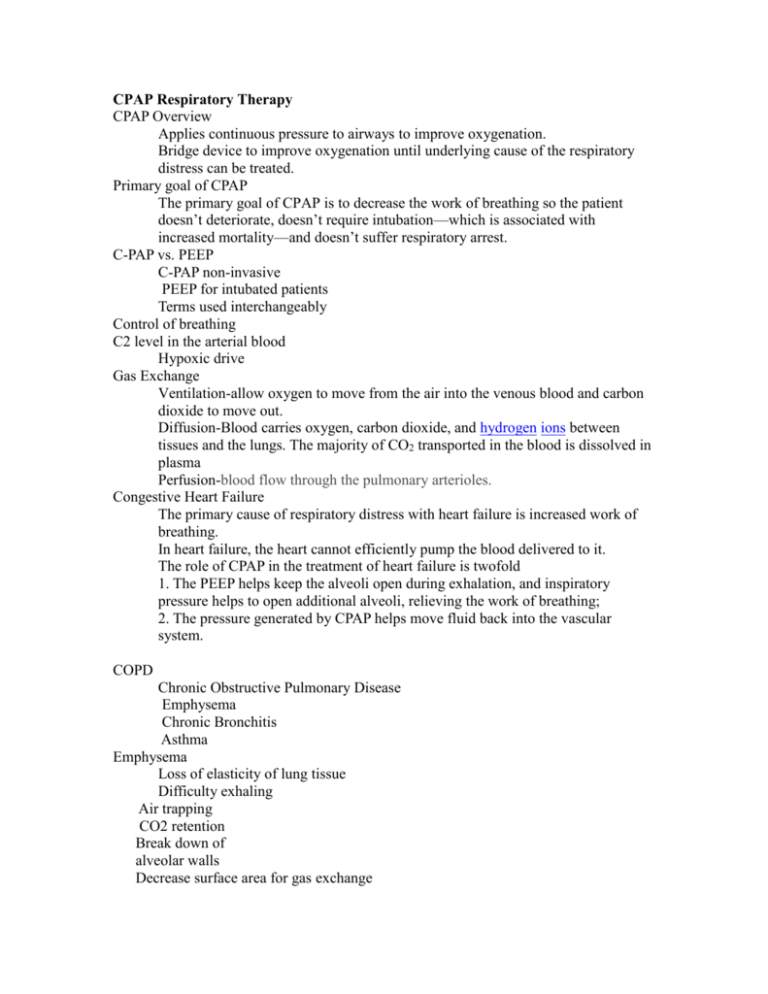
CPAP Respiratory Therapy CPAP Overview Applies continuous pressure to airways to improve oxygenation. Bridge device to improve oxygenation until underlying cause of the respiratory distress can be treated. Primary goal of CPAP The primary goal of CPAP is to decrease the work of breathing so the patient doesn’t deteriorate, doesn’t require intubation—which is associated with increased mortality—and doesn’t suffer respiratory arrest. C-PAP vs. PEEP C-PAP non-invasive PEEP for intubated patients Terms used interchangeably Control of breathing C2 level in the arterial blood Hypoxic drive Gas Exchange Ventilation-allow oxygen to move from the air into the venous blood and carbon dioxide to move out. Diffusion-Blood carries oxygen, carbon dioxide, and hydrogen ions between tissues and the lungs. The majority of CO2 transported in the blood is dissolved in plasma Perfusion-blood flow through the pulmonary arterioles. Congestive Heart Failure The primary cause of respiratory distress with heart failure is increased work of breathing. In heart failure, the heart cannot efficiently pump the blood delivered to it. The role of CPAP in the treatment of heart failure is twofold 1. The PEEP helps keep the alveoli open during exhalation, and inspiratory pressure helps to open additional alveoli, relieving the work of breathing; 2. The pressure generated by CPAP helps move fluid back into the vascular system. COPD Chronic Obstructive Pulmonary Disease Emphysema Chronic Bronchitis Asthma Emphysema Loss of elasticity of lung tissue Difficulty exhaling Air trapping CO2 retention Break down of alveolar walls Decrease surface area for gas exchange Chronic Bronchitis Chronic Inflammation of bronchiole tree with increased mucous production Difficulty exhaling – Air trapping – CO2 retention Asthma Intermittent Bronchoconstriction Difficulty exhaling – Air trapping – CO2 retention Physiological Benefits of C-PAP Increase in alveolar pressure – Stop fluid movement into alveoli – Improves gas distribution – Prevents alveolar collapse – Improves re-expansion of alveoli Reduces work of breathing Reduces respiratory muscle fatigue Increases intrathoracic pressure – Improves cardiac output to a point – Too much PEEP decreases cardiac output Decreases need for intubation and associated complications Hazards/Complications of C-PAP Airway – Mask impairs access to patient’s airway – C-PAP does not ventilate the patient – Gastric distension / vomiting • Aerophagia (swallowing air) sensitive patients – Gastric stapling – Upper GI surgery Hypoxia – Loss of oxygen supply • Empty oxygen tank • Disconnection of Oxy-PEEP from oxygen source – Mask Leak – Rebound hypoxia may be more severe than initial hypoxia Hypotension – Increased intrathoracic pressure causes • Decreased venous return • Decreased cardiac output – Increased pulmonary pressure causes Decreased blood flow through pulmonary vessels •Decreased cardiac output Patient Discomfort – Requires patient cooperation to tolerate a tightly fitting mask • Sensation of smothering or claustrophobia – Use trial to introduce patient to device prior to securing head strap – Consider sedation for extreme anxiety with orders from Medical Control (ALS) Procedure Prepare Patient – Position Stretcher at 45 degrees or higher – Inform patient of procedure Mask Application – Trial to introduce device • Explain patient will feel positive oxygen pressure – Hold mask gently on patient’s face ensuring good seal – Once patient accepts mask, secure mask with straps – Deflate mask as needed to get good seal On-Going Care / Monitoring – Reassess at least every 5 minutes • Patient’s impression of difficulty breathing • Vital signs • Lung sounds • SpO2 – Observe for complications • Hypotension • Barotrauma • Worsening dyspnea If patient continues to have severe difficulty breathing after 5 minutes, consider increasing PEEP to 10 cm H2O – Systolic BP must be at least 90 mmHg – CAREFULLY watch for complications of increased PEEP Discontinuing CPAP C-PAP usually is not discontinued in the field High PEEP level may require weaning Rebound hypoxia can be worse than initial hypoxia



